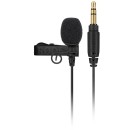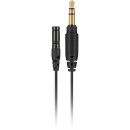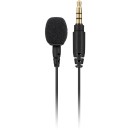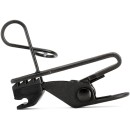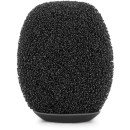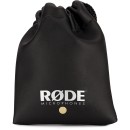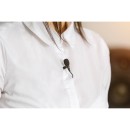RODE Lavalier GO Lavalier Microphone: A Comprehensive Review
- Professional-grade lavalier microphone for broadcast-quality audio.
- Omnidirectional polar pattern for clear and consistent sound capture.
- 3.5mm TRS connector for compatibility with a wide range of devices.
- Kevlar reinforced cable for durability and longevity.
- Compact and lightweight design for discreet use.
- Includes a foam pop shield to minimize wind noise and plosives.
- Compatible with RODE Wireless GO and most recording devices with a 3.5mm input.
In-Depth Analysis of the RODE Lavalier GO Specifications
The RODE Lavalier GO is a high-quality lavalier microphone designed for use with a wide range of devices, providing professional-grade audio capture in a compact form. Ideal for filmmakers, vloggers, and journalists, it delivers clear and precise sound, making it a versatile tool for various recording applications. The microphone is compatible with devices that have a 3.5mm TRS microphone input, ensuring broad usability across different equipment.
Built with convenience in mind, the Lavalier GO features a discreet design that is easy to clip onto clothing, offering unobtrusive audio capture. The microphone includes a foam pop shield to minimize wind noise and plosives, ensuring the captured audio is clean and clear. Additionally, its Kevlar-reinforced cable adds durability, making it reliable for on-the-go use without the worry of wear and tear.
The Lavalier GO is designed to pair seamlessly with the RODE Wireless GO system, but it also functions well with other recording devices, enhancing its flexibility for users. Its omnidirectional polar pattern ensures that sound is captured evenly from all directions, providing consistent audio quality regardless of the microphone's positioning. This feature makes it an excellent choice for interviews, presentations, and other scenarios where capturing natural sound is essential.
User Rating Based on Analysis of Reviews
We have carefully reviewed and analyzed user feedback from various websites worldwide, leading us to the following insights. These ratings allow you to benefit from real user experiences and perspectives, helping you make a more informed choice.
Purchase Value
85% of users expressed satisfaction with the purchase value of the RODE Lavalier GO, highlighting its affordability compared to other professional-grade lavalier microphones. Many users appreciated the balance between cost and performance, noting that it provides exceptional audio quality for its price point, making it a valuable investment for personal and professional use.
15% of users felt that the purchase value was not entirely justified. These users often compared the Lavalier GO to higher-end models and found it lacking in certain advanced features or durability, which led them to believe that the microphone did not fully meet their expectations for the price.
Quality of Materials
80% of users were satisfied with the quality of materials used in the RODE Lavalier GO. They described the microphone as well-constructed and durable, appreciating the robust clip and the flexibility of the cable, which together contributed to reliable performance in various settings.
20% of users expressed dissatisfaction with the materials, citing concerns about the cable's long-term durability. Some users reported issues with the cable becoming frayed or the clip losing its grip over time, which detracted from their overall satisfaction with the product.
Sound Quality
90% of users praised the sound quality of the RODE Lavalier GO, noting its clear and professional-grade audio capture. Users found it effective in minimizing background noise while delivering crisp and natural vocal recordings, which was especially appreciated by content creators and professionals.
10% of users were not satisfied with the sound quality, finding it somewhat lacking in depth or bass response. These users often compared the microphone to more expensive models and felt that it did not capture the full spectrum of their voice or instruments as effectively.
Ease of Use
95% of users found the RODE Lavalier GO extremely easy to use, praising its plug-and-play functionality and intuitive setup. Users appreciated the simplicity of connecting the microphone to a variety of devices, which made it accessible even for those not technically inclined.
5% of users experienced difficulties with ease of use, primarily due to compatibility issues with certain devices. These users found that additional adapters were sometimes necessary, complicating the otherwise straightforward setup process.
Portability
92% of users were impressed by the portability of the RODE Lavalier GO, highlighting its compact size and lightweight design as ideal for travel or on-the-go recording sessions. Users valued the convenience of carrying it in small bags without adding significant weight.
8% of users mentioned concerns about portability, particularly regarding the lack of a dedicated case or protective cover, which made them wary of potential damage when transporting the microphone.
Durability
78% of users expressed satisfaction with the durability of the RODE Lavalier GO, noting that it withstands regular use well. Many users reported that the microphone maintained its quality over time with proper care, which contributed to their positive perception of its longevity.
22% of users felt that the microphone was not as durable as expected. They reported issues with the cable's fragility and the clip's susceptibility to breakage, which led to concerns about its long-term reliability.
Design
88% of users appreciated the design of the RODE Lavalier GO, describing it as sleek and unobtrusive. Users valued its professional appearance, which allowed it to blend seamlessly in various recording environments without drawing attention.
12% of users were less satisfied with the design, particularly in terms of the cable length or the microphone's visibility when worn. These users desired more customization options to better suit their specific recording needs and preferences.
Compatibility
84% of users were satisfied with the compatibility of the RODE Lavalier GO, appreciating its ability to connect with a wide range of devices, including smartphones, cameras, and audio recorders. This versatility was a significant factor in user satisfaction, as it enhanced the microphone's usability across different platforms.
16% of users encountered compatibility issues, particularly with certain smartphone models or older recording equipment. These users found that additional adapters or software adjustments were necessary, which led to frustration and reduced their overall satisfaction.
Cable Length
82% of users found the cable length of the RODE Lavalier GO to be adequate for most recording situations, providing enough flexibility to move around while recording without feeling restricted. This aspect was particularly appreciated in dynamic filming or interview settings.
18% of users were dissatisfied with the cable length, either finding it too short for their specific needs or too long, leading to tangling issues. These users suggested offering different cable length options to better accommodate various recording environments.
Price
86% of users considered the price of the RODE Lavalier GO to be reasonable, especially given the microphone's performance and build quality. The cost-effectiveness of the product was a driving factor for many users when choosing this model over more expensive alternatives.
14% of users felt the price was slightly high, particularly when compared to budget models that offer similar basic features. These users were looking for additional features or accessories included in the price to enhance the overall value proposition.
Microphone Sensitivity
89% of users were pleased with the microphone sensitivity of the RODE Lavalier GO, noting its ability to capture subtle nuances in sound without requiring significant post-processing. Users found this feature especially beneficial for natural-sounding recordings.
11% of users found the microphone sensitivity to be lacking, particularly in capturing low-volume sounds or in noisy environments. These users suggested improvements in this area to enhance the microphone's versatility in different acoustic settings.
Noise Cancellation
83% of users appreciated the noise cancellation capabilities of the RODE Lavalier GO, noting its effectiveness in reducing ambient noise and focusing on the subject's voice. This feature was particularly appreciated in outdoor or crowded environments.
17% of users were dissatisfied with the noise cancellation, finding it insufficient in very noisy environments or when compared to dedicated noise-canceling microphones. These users felt that more advanced noise reduction technology would significantly enhance the microphone's performance.
Clip Strength
75% of users were content with the clip strength of the RODE Lavalier GO, finding it sufficient to securely attach the microphone to clothing without slipping. This reliability was valued in professional settings where stable placement is crucial.
25% of users were unhappy with the clip strength, reporting that it occasionally loosened or detached during use. These users suggested improvements in the clip's grip and durability to prevent such issues.
Versatility
87% of users found the RODE Lavalier GO to be highly versatile, suitable for a wide range of recording scenarios from interviews to vlogs. Its adaptability to different devices and environments was a key factor in user satisfaction.
13% of users felt the microphone's versatility was limited, particularly in specialized recording situations where specific features or settings were required. These users desired more customization options to better tailor the microphone to their unique needs.
User Manual Clarity
88% of users found the user manual for the RODE Lavalier GO to be clear and easy to understand, providing helpful guidance for setup and operation. This clarity contributed to a smooth user experience, especially for those new to audio equipment.
12% of users were dissatisfied with the user manual, finding it lacked detailed troubleshooting tips or advanced usage instructions. These users felt that more comprehensive documentation would enhance their understanding and utilization of the microphone's features.
Brand Reputation
91% of users expressed high satisfaction with the brand reputation of RODE, citing trust in the company's history of producing quality audio equipment. This positive perception influenced their decision to purchase and their overall satisfaction with the Lavalier GO.
9% of users were less influenced by the brand reputation, focusing instead on their direct experience with the product. These users felt that the brand's reputation did not necessarily correlate with their expectations or the microphone's performance.
Customer Support
84% of users were satisfied with the customer support provided by RODE, noting quick response times and helpful assistance in resolving issues. This support was valued by users who encountered technical difficulties or had inquiries about the product.
16% of users expressed dissatisfaction with customer support, citing delays in response or inadequate solutions to their problems. These users felt that more efficient and comprehensive support would improve their overall experience with the company.
Warranty
82% of users were content with the warranty offered by RODE for the Lavalier GO, finding it to be a reassuring aspect of their purchase. The warranty provided users with peace of mind regarding potential defects or issues.
18% of users were dissatisfied with the warranty terms, feeling that it was too limited in duration or coverage. These users desired longer or more inclusive warranty options to better protect their investment.
Setup Process
93% of users found the setup process for the RODE Lavalier GO to be straightforward and hassle-free, allowing them to quickly get started with recording. This ease of setup was particularly appreciated by users with minimal technical expertise.
7% of users experienced difficulties during setup, often due to compatibility issues or lack of clear instructions. These users suggested providing more detailed setup guides or online resources to assist with initial configuration.
Aesthetics
86% of users were pleased with the aesthetics of the RODE Lavalier GO, appreciating its sleek and professional appearance. The microphone's design was considered both functional and visually appealing, enhancing its suitability for various recording contexts.
14% of users were less satisfied with the aesthetics, particularly regarding the visibility of the microphone when worn. These users desired a more discreet design to better blend in during on-camera appearances or presentations.
Accessories
77% of users were satisfied with the accessories included with the RODE Lavalier GO, such as the windscreen and clip, which enhanced the microphone's usability in different environments. Users appreciated these additions as valuable complements to the main product.
23% of users felt that the accessories were insufficient or not of the same quality as the microphone itself. These users suggested including more or higher-quality accessories, such as a carrying case or additional windscreens, to improve the overall package.
In the following sections, we will delve into the specifications, advantages, and disadvantages of the RODE Lavalier GO Lavalier Microphone. This article provides a thorough examination of its features to help you decide if it's the right choice for your audio needs.
Pros:
- Compact and lightweight design, making it easy to carry and use.
- High-quality audio capture suitable for professional use.
- Compatible with a wide range of devices, including smartphones and cameras.
- Affordable price point for a professional-grade lavalier microphone.
- Durable build quality ensuring longevity.
Cons:
- Requires adapters for certain devices not equipped with TRS inputs.
- Cable length may be limiting for some applications.
- Lacks some advanced features found in higher-end models.
- Omnidirectional pickup pattern may capture unwanted background noise.
Microphone
| Form Factor | Lavalier |
|---|---|
| Compatible Transmitters | RODE Wireless: GO |
| Sound Field | Mono |
| Element Type | Electret Condenser |
| Polar Pattern | Omnidirectional |
Form Factor: The form factor refers to the physical design and build of the microphone. A lavalier microphone is small and typically clipped onto the user's clothing, making it ideal for hands-free operation and discreet audio recording. Its compact size and lightweight design allow for easy portability and minimal visibility on camera.Show More
Compatible Transmitters: This specification indicates which transmitters the microphone is designed to work with. The RODE Lavalier GO is compatible with the RODE Wireless GO system. This compatibility ensures seamless integration and optimal performance when paired with the specified transmitter, providing a reliable wireless audio solution.
Sound Field: The sound field refers to the type of audio signal the microphone captures. A mono sound field means that the microphone records a single channel of audio. Mono recordings are useful for capturing clear and direct sound, particularly when the primary focus is on a single audio source, such as a speaker or presenter.
Element Type: The element type describes the microphone's transducer technology. An electret condenser element is known for its sensitivity and ability to capture a wide frequency range, resulting in detailed and accurate sound reproduction. This type of microphone element is commonly used in lavalier microphones due to its small size and high-quality audio capture.
Polar Pattern: The polar pattern determines the microphone's sensitivity to sound from different directions. An omnidirectional polar pattern means the microphone can pick up sound equally from all directions. This is beneficial for capturing a natural and consistent audio environment, making it suitable for situations where the sound source may move or when ambient sound is desired.
Performance
| Frequency Range | 20 Hz to 20 kHz |
|---|---|
| Maximum SPL | 110 dB SPL |
| Sensitivity | -35 dB |
| Dynamic Range | 83 dB |
| Signal-to-Noise Ratio | 67 dB |
Frequency Range: The frequency range of a microphone indicates the span of audio frequencies it can effectively capture. Ranging from 20 Hz to 20 kHz, this microphone can record the full spectrum of sound audible to the human ear, making it suitable for recording various audio sources with precision and clarity.Show More
Maximum SPL: Maximum Sound Pressure Level (SPL) refers to the loudest sound the microphone can handle before distortion occurs. A maximum SPL of 110 dB SPL means that this microphone can capture loud sounds without compromising audio quality, making it ideal for environments where high sound levels are present.
Sensitivity: Sensitivity is a measure of how efficiently a microphone converts acoustic sound into an electrical signal. With a sensitivity of -35 dB, this microphone is adept at picking up softer sounds and providing a good signal level for recording, which is beneficial for capturing detailed audio in a variety of settings.
Dynamic Range: The dynamic range of a microphone indicates the range between the quietest and loudest sounds it can capture without distortion. An 83 dB dynamic range suggests that this microphone can handle a wide range of sound intensities, from subtle audio nuances to more pronounced sounds, providing versatility in different recording scenarios.
Signal-to-Noise Ratio: The signal-to-noise ratio (SNR) measures the level of the desired audio signal relative to the background noise. A 67 dB SNR reflects the microphone's ability to deliver clear audio by minimizing unwanted noise, ensuring that the recorded sound is both clean and intelligible.
Connectivity
| Output Connector | 1x 1/8" / 3.5 mm TRS Male |
|---|---|
| Cable Length | 3.9' / 1.2 m |
Output Connector: The output connector refers to the type of connection used to link the microphone to other audio devices. In this case, it is a 1/8" or 3.5 mm TRS (Tip, Ring, Sleeve) male connector. This is a standard audio jack used commonly in many consumer audio equipment, such as smartphones, cameras, and computers. The TRS male connector ensures compatibility with a wide range of devices, making it versatile for different recording situations.Show More
Cable Length: The cable length indicates the distance between the microphone and the device it is connected to. At 3.9 feet or 1.2 meters, this length provides a balance between flexibility and manageability. It is long enough to allow some movement and positioning flexibility for the user, while still being short enough to avoid excessive tangling or inconvenience during use. This length is ideal for personal use, interviews, or close-mic applications where the user is relatively close to the recording device.
Power
| Power Sources | Plug-In Power |
|---|---|
| Operating Voltage | 2.7 V (Plug-In Power) |
Power Sources: The power source for the RODE Lavalier GO is plug-in power. This means the microphone is designed to draw power directly from the device it is connected to, such as a camera or audio recorder, without needing an external battery. This feature is convenient as it simplifies the setup and eliminates the need to worry about battery levels in the microphone itself.Show More
Operating Voltage: The operating voltage for the RODE Lavalier GO is 2.7 V, supplied through plug-in power. This voltage is sufficient to power the microphone's internal components, ensuring optimal performance and audio quality. The specified voltage is typically compatible with most devices that provide plug-in power, making the microphone versatile and easy to use across different systems.
Physical
| Color | Black |
|---|---|
| Dimensions | ø: 0.2 x L: 0.94" / ø: 0.5 x L: 2.39 cm (Capsule) |
| Weight | 0.56 oz / 16 g |
Color: The RODE Lavalier GO comes in a sleek black color, which is a popular choice for microphones due to its professional appearance and ability to blend seamlessly into various environments. This is particularly important for applications such as interviews, presentations, and performances where the microphone should not distract the audience.Show More
Dimensions: The dimensions listed for the capsule of the microphone indicate its compact size. With a diameter of 0.2 inches (0.5 cm) and a length of 0.94 inches (2.39 cm), this microphone is designed to be discreet and unobtrusive. Its small size makes it easy to conceal, which is ideal for on-camera use or situations where visual discretion is important.
Weight: Weighing in at just 0.56 ounces (16 grams), the RODE Lavalier GO is extremely lightweight. This ensures comfort during extended periods of use, as the microphone will not weigh down clothing or become uncomfortable for the wearer. The light weight also facilitates easy transport and setup, making it a practical choice for professionals on the go.
Packaging Info
| Package Weight | 0.1 lb |
|---|---|
| Box Dimensions (LxWxH) | 4.1 x 3.3 x 1.1" |
Package Weight: This specification refers to the total weight of the microphone package. At 0.1 lb, it indicates that the package is lightweight, making it highly portable and convenient for users who need to carry it around for interviews, vlogging, or other recording purposes. A lighter package weight also reduces shipping costs and ease of handling.Show More
Box Dimensions (LxWxH): These dimensions provide the length, width, and height of the box in which the microphone is packaged. Measuring 4.1 x 3.3 x 1.1 inches, the compact size of the box indicates that the lavalier microphone is designed to be space-efficient, which is beneficial for storage and transport. It also suggests that the microphone and any included accessories are organized in a way that minimizes excess packaging.
Customer Images
Videos
Customer Questions
How do I connect the RODE Lavalier GO to my smartphone?
To connect the RODE Lavalier GO to your smartphone, you will need a TRRS adapter since the microphone comes with a TRS connector. Use a RODE SC4 or similar TRS to TRRS adapter, plug the microphone into the adapter, and then connect it to the smartphone's headphone jack.
Why is my RODE Lavalier GO microphone not picking up sound?
Ensure the microphone is securely plugged into the recording device or adapter. Check if the microphone is muted on the device and verify that the recording software settings are configured to use the external microphone.
How do I attach the RODE Lavalier GO to clothing?
Use the provided clip to attach the RODE Lavalier GO to clothing. Open the clip and slide it over the fabric, ensuring the microphone is positioned close to the mouth for optimal sound capture.
Can the RODE Lavalier GO be used with a DSLR camera?
Yes, the RODE Lavalier GO can be used with a DSLR camera. Simply connect the microphone directly to the camera's microphone input using the TRS connector.
What should I do if I hear a buzzing noise in my recordings?
A buzzing noise can be caused by electronic interference. Make sure the microphone cable is not near any electronic devices or power sources. Additionally, check all connections for secure attachment and try using a different recording device if the problem persists.
Is the RODE Lavalier GO compatible with iPhones?
Yes, it is compatible with iPhones, but you will need a TRRS adapter like the RODE SC4, and an additional Lightning to 3.5mm adapter if your iPhone lacks a headphone jack.
How do I clean and maintain the RODE Lavalier GO microphone?
To clean the microphone, gently wipe it with a dry, soft cloth. Avoid using any liquids or cleaning agents. Store it in a dry, safe place when not in use to prevent damage.
Why is my audio quality poor when using the RODE Lavalier GO?
Ensure the microphone is positioned correctly and close to the speaker's mouth. Check that the recording device settings are optimized for external microphone input. Try testing the microphone in a quiet environment to rule out background noise interference.
Can I use the RODE Lavalier GO with a computer for video conferencing?
Yes, you can use it with a computer for video conferencing. Plug the microphone into the computer's microphone input via an appropriate adapter if needed, and configure your conferencing software to use the external microphone.
What should I do if the microphone clip is loose or broken?
If the clip is loose, try tightening it manually or adjusting it for a better fit. If it's broken, consider purchasing a replacement clip from RODE or a compatible third party.
